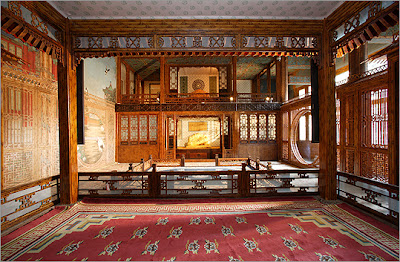 |
| Portrait of the Qianlong Emperor (1711 - 1799) on a silk scroll in court dress by an anonymous artist. Image courtesy of the Palace Museum, Beijing. |
Thus was the imperial closing of a letter to England's King George III by the Chinese Qianlong Emperor. He was the sixth emperor of the Qing Dynasty, and a successful military leader and a major patron of the arts. He commissioned a catalog of all important works on Chinese culture, the Siku Quanshu, Complete Library in Four Branches of Literature. Using about 15,000 copyists, it took twenty years to produce the 36,000 volumes of 3,450 complete works. This is the largest collection of books in Chinese history, and perhaps the most ambitious editorial project ever.
 |
| An interior of the Qianlong Garden Restoration Project that has been restored. |
While it preserved many works, it also suppressed works of political opponents. The full editing of the Siku Quanshu took about ten years. In the process 3,100 works and 150,000 copies of books were banned or burned. "Literary Inquisition" was the official persecution of intellectuals for their writings in Imperial China, and the Qing dynasty were infamous for using it. A nefarious political tool, even a single phrase or word could be considered offensive by the ruler. Persecution of those found guilty could result in beheading, mutilated corpses, or victims sliced into pieces until dead. Sometimes the punishment would extend to the families of those found guilty.
 |
| A fan made from Yanghe Jingshe wood, brass, and paint. |
The Qianlong Emperor was more favorably known as a patron of the arts. A very prolific poet and essayist himself, over 40,000 poems and 1,300 prose texts that he wrote were published between 1749 and 1800. Ceramics, pottery, enameling, lacquer and metal work prospered, and much of his own collection is now shared in the Percival David Foundation in London. Many pieces of his fine art collection can be found in the British Museum and the Victoria and Albert Museum.
 |
| Screen from the Garden site. |
As an emperor, he presided over the Qing dynasty, China's last, at the zenith of its wealth and power. In 1771 he created a retirement retreat within the Forbidden City, and filled it with paintings and decorative and religious works. Deep within the Forbidden City, this two-acre retreat truly was forbidden. Since the last emperor left in 1924 not many have seen this site. The Qianlong Garden Restoration Project is being restored with help from the World Monument Fund.
 |
| An imperial theater room with stage. |
The garden has four courtyards and 27 pavilions and structures. The decorations and furnishings reflect the spectacular art from this period of Chinese history, and the site has remained unchanged from imperial times. Imagine! Untouched since 1795! Only one building is finished in its restoration, and the entire garden is expected to be done by 2019.
 |
| Shrine and statue of Jingang, made of either calcite or lapis lazuli, with gilt, copper, silver, and glass. |
With names like the Studio of Exhaustion from Diligent Service (the only one whose restoration is completed), the Supreme Chamber of Cultivating Harmony, the Studio of Self-restraint, the Pavilion of Purification, and the Terrace for Collecting Morning Dew, who wouldn't want to retire here?
 |
| Mural from one of the interiors of the site. |
An exhibition organized by the Peabody Essex Museum in partnership with the Palace Museum and with cooperation from the World Monument Fund opened last September and ended earlier this month. It will go on exhibit at the MET beginning February 1st for three months, then move on to open at the Milwaukee Art Museum on June 11th. There was some consternation in China that these objects were to be shown publicly for the first time in the U.S., but in the interest of promoting the restoration of the entire Forbidden City site, it was decided to allow the Peabody Essex Museum to present the first glimpse of these objects anywhere in the world.
 |
| A hanging shrine on silk with intricate depictions of supernatural beings. The Qianlong Emperor holds the center position and is shown in gold. |
These objects represent the crème de la crème of extant art at the time. And most reflect the contemplative aspect of the Qianlong Emperor's life as a scholar, a Buddhist, and a Confucian. It was not about the power and the glory, but rather the rich life and informed taste of the elite mind.
 |
| A wood cabinet made of lacquer and gilding. |
With the release of these objects one can only hope that further cultural sharing will be forthcoming from China. Their complex and rich history has only begun to be understood, and these cultural icons will be an interesting and important way to "read" their history.
 |
| A hanging panel with niches and Buddhist figures. |
Locked away, hidden to all but a few, these items and the site itself will be available to all with an interest in a unique time and place.
***************
All images courtesy of the Peabody Essex Museum, except as noted.
*******************************
No comments:
Post a Comment
NOTE: COMMENTS WITH LINKS WILL NOT BE POSTED!